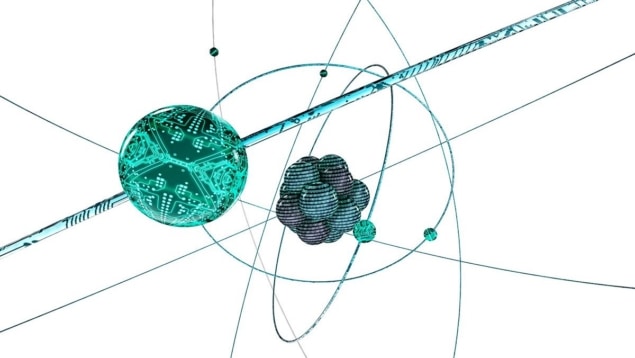Carbon-capture technology could benefit from quantum computing
05 Apr 2023
Quantum chemistry: artistic conception of a molecule being simulated by a quantum computer. (Courtesy: iStock/thelightwriter)
Quantum computers could be used to study chemical reactions related to carbon capture by doing calculations that are beyond the capability of even the most powerful classical computers – according to researchers in the US. The team at the National Energy Technology Laboratory (NETL) and the University of Kentucky used a supercomputer to simulate the quantum calculations. This revealed that the computation could be done much faster on quantum computers of the future.
Increasing levels of carbon dioxide in the atmosphere are driving global warming so scientists are keen to develop new ways of absorbing the gas and storing it. One way of doing this is to use chemical reactions that consume carbon dioxide, creating substances that can be safely stored. However, existing carbon-capture reactions tend to be energy intensive and expensive. As a result, researchers are on the lookout for new carbon-capture reactions and also for ways to predict reaction efficiencies at realistic temperatures and pressures.
Designing optimal reaction pathways requires a detailed understanding of the microscopic quantum properties of the molecules involved. This is a challenge because precise calculations of the quantum nature of chemical reactions are notoriously difficult to do on conventional computers. The required computational resources increase exponentially with the number of atoms involved, making simulating even simple reactions very difficult. Fortunately, this exponential scaling does not occur if the calculations are done on quantum computers.
Small and noisy
Quantum computers are still in the early stages of development and the largest machines are limited to a few hundred quantum bits (qubits). They are also plagued by noise, which inhibits quantum calculations. Whether these noisy intermediate-scale quantum computers (NISQs) can do useful calculations is therefore still a subject of much debate. One promising avenue is combining quantum and classical computers to mitigate the effects of noise in quantum algorithms. This approach includes the variational quantum eigensolver (VQE), which was used by the NETL/Kentucky researchers.
In a VQE, a classical computer generates a guess for the quantum configuration of the reacting molecules. Then, the quantum computer calculates the energy of that configuration. The classical algorithm iteratively adjusts that guess until the lowest energy configuration is found. Thus, the stable lowest energy state is computed.
In recent years, quantum computing hardware running VQE algorithms has successfully determined the binding energy of chains of hydrogen atoms and the energy of a water molecule. However, neither calculation achieved quantum advantage – which occurs when a quantum computer does a calculation that a classical computer cannot do in a realistic amount of time.
Simulated quantum calculation
Now, the NETL/Kentucky team has explored how VQE algorithms could be used to calculate how a carbon dioxide molecule reacts with an ammonia molecule. This involved using a classical supercomputer to simulate the quantum calculation, including the noise levels expected in a NISQ.
Past studies have looked at how ammonia could be used for carbon capture, but it is unlikely that these processes could be used on a large-scale basis. However, amines – complex molecules that resemble ammonia – show potential for large-scale use. As a result, studying how carbon dioxide and ammonia react is an important first step towards using VQEs to study reactions involving more complex amines.
“We have to pick a representative reaction to do the modelling,” says Yueh-Lin Lee, who is a team member at NETL. Lee points out that their simplified reaction allows them to test how current quantum computing algorithms and devices fare with increasing molecular size: from carbon dioxide to ammonia to the NH2COOH molecule that the reaction produces.
While the team was able to calculate the chemical pathway of carbon dioxide reacting with ammonia with their simulated quantum algorithm, obtaining the vibrational energy levels of NH2COOH proved difficult. Their supercomputer obtained an answer after three days of calculations, allowing the team to conclude that a quantum computer with sufficiently low noise should be able to do the calculation much faster. Furthermore, they found that if the product molecule was any larger, a classical supercomputer computer would not be able to solve the problem.
Real-life conditions
The researchers point out that calculating precise vibrational energy levels is crucial for understanding how the reaction would fare in real-life conditions, at non-zero temperatures.
“If you want to look at the reaction in realistic conditions, not only do you need the total energy but vibrational properties as well,” says team member Dominic Alfonso at NETL. “A classical simulation is not able to calculate the vibrational properties, whereas we show that a quantum algorithm can do that. So even at this stage, we may see a quantum advantage.”READ MORE

Existing quantum computers have enough qubits to perform the classically out-of-reach simulation of vibrational levels. What remains to be seen is whether such quantum computers have low enough noise to do the calculations – although noise simulations predict success.
However Kanav Setia, who is chief executive officer of the US-based quantum computing software provider qBraid and a VQE expert, has expressed doubt that the NETL/Kentucky model captures the true noise level of existing quantum computers. Setia, who has not involved in the research, says “Given the recent progress in many other architectures, performing this study on quantum computers may be possible in the coming years.”
The team is now collaborating with IBM quantum to implement their ideas on an existing quantum computer, and are hopeful they may demonstrate a quantum advantage. They report their findings in AVS Quantum Science.
Dina Genkina is a science writer and podcast producer based in New York City
FROM PHYSICSWORLD.COM 11/4/2023

Δεν υπάρχουν σχόλια:
Δημοσίευση σχολίου